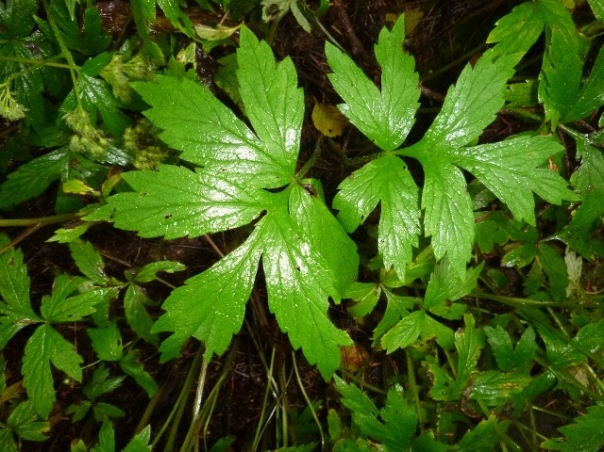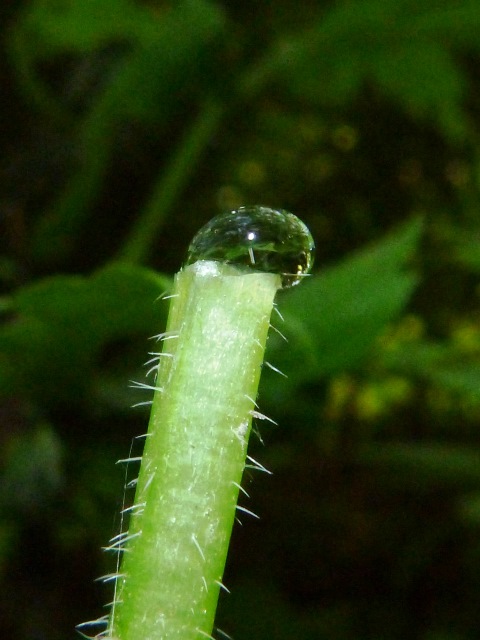Thirsty Plants!
How Do Plants Get a Drink?
By Bruce Rottink, Volunteer Nature Guide and Retired Research Forester
With summer comes a host of delicious fruits for us to enjoy. Cherries, peaches and apples top my list. They’re sweet and juicy. Have you ever stopped to think that the juiciness is primarily due to water the plant pulled from the soil? The same is true for all the fruits at Tryon Creek State Natural Area (TCSNA). How do the plants get the water out of the soil and move it up into their leaves and fruits? From the viewpoint of the plant, this is one of the most important things it does. No water means no leaves, no fruits and ultimately, no plants!
How does water get into the plant?
Most of the plant’s water comes in through the roots. The process of getting water into the roots relies on two things. First, a physical structure called a “semi-permeable membrane” and secondly, a physical process called “osmosis”.
Let’s start with the semi-permeable membrane. “Semi-permeable” means that some things can go through the membrane, and other things can’t! Every living cell in the whole world, plant and animal alike, is contained within a semi-permeable membrane. You have gazillions of them in your own body. Plants have semi-permeable membranes around the living core of each cell, although most are also encased in a rigid, non-living “cell wall” on the outside. You can think of the semi-permeable membrane as a thin film with small holes in it. In most cases, water can go through these holes, but other molecules, especially large molecules like plant sugars, can’t go through these holes.
The other key to getting water out of the soil is the process of “osmosis.” Osmosis simply means that molecules will move from areas of high concentration to areas of low concentration. For example, you can tell when someone wearing perfume walks into a room. The perfume molecules move from the area of their highest concentration (the perfume-wearer’s body) to areas of low concentration, namely the whole rest of the room. This movement of molecules is called diffusion. This is similar to osmosis, except that in osmosis the molecules have to go through the holes in the semi-permeable membrane.
So how does the osmosis work?
Remember that the water is moving from areas of high concentration of water to areas of low concentration of water. The water out in the soil is relatively pure. In contrast, inside the root are a host of molecules, such as sugars created by the plant. So the concentration of water inside the plant is much lower than the concentration of water outside of the plant. Thus the water moves from the soil into the plant via osmosis. The diagram below illustrates the key parts of osmosis.
Once the water is in the roots, how does it move up to the leaves?
You were hoping there was just one simple answer, weren’t you? Sorry, not this time! There are a couple of different processes that plants use to move the water from the roots up to the leaves. For this posting, I’ll just talk about one of them which is called “root pressure.” Caution: Root pressure is a technique which is important for some plants, but scientists have found other species of plants that don’t use root pressure at all.
Root pressure is something which is most important for short plants that are growing in relatively moist soils. As the roots suck up more and more water, the roots can’t just keep swelling up bigger and bigger, the water has to go somewhere else. The plant solves this problem by pushing the water up through the stems to the leaves. Two species at TCSNA which clearly use root pressure are jewelweed (Impatiens capensis) and Pacific waterleaf (Hydrophyllum tenuipes). Check out their unique flowers, a good reference when trying to identify these plants.
For plants that use root pressure, something very interesting happens when the soil is fairly wet and the weather is humid. Normally a fair amount of water is lost through tiny pores on the leaves by the process called “transpiration.” In humid weather very little water escapes from the plants through transpiration. Soon the leaves are wondering what to do with all this water that’s being pushed up to them by the roots.
Naturally, the leaves have a solution. The leaves force the water out in a process called “guttation.” The leaves force the water out through special structures called “hydathodes.” These hydathodes are most frequently found on the end of the teeth on the edge of the leaves. You can see the results of guttation in the photo below.
Another plant at TCSNA that also does this is the Pacific waterleaf, which you can see below.
I’ll bet you’ve wondered why they call this plant “waterleaf” haven’t you? Well now… [Stop right here! This is Bruce’s conscience speaking. Bruce has found not one shred of evidence in the scientific literature that guttation is why they call this plant “waterleaf.” I have to watch him like a hawk!]
The pattern of exuded water on the leaf is much different from if the leaf has been rained on. Below is a picture of a Pacific waterleaf leaf after a rainstorm. The water in this case is just a thin shiny layer across the entire leaf, as you can see (or not so much) in the photo below. This shows that rainwater is not the cause of the droplets of water on the teeth of the leaf.
What other evidence is there of root pressure?
The ultimate evidence of root pressure is shown below. I chose a Pacific waterleaf plant less than 2 feet tall. It was growing in fairly wet soil. Then, after getting the permission of the Park Rangers, I carefully cut off the top of the stem. I went on a hike for about an hour and then returned and took the photo below.
The droplet of water at the cut tip of the stem has been forced up by root pressure. It clearly hasn’t been pulled up by the leaves, because there are no leaves to pull up this water.
If you want to see guttation for yourself, come to the park in the early morning after a big rainstorm. Look carefully at the jewelweed near either Obie’s Bridge or Beaver Bridge. You can also check out the Pacific waterleaf on Old Main, or other trails. You’ll be able to see for yourself that the plants have done a good job of getting a nice big drink of the water from the soil.
Posted on June 29, 2015, in Plants & Wildlife and tagged guttation, hydathodes, jewelweed, osmosis, plants, Root pressure, Roots, semi-permeable membrane, transpiration, Tryon Creek State Natural Area, waterleaf. Bookmark the permalink. 2 Comments.






So how do the thirsty plants get water when the soil in many places is dry, as now?
There are lots of answers to your inquiry, especially if I can expand the scope of your question just a bit.
1) Sometimes they can’t absorb any water from the soil, and they die.
2) Sometimes they are unable to absorb adequate water from the soil, and they cope by reducing their “demand” for water. Oftentimes this amounts to shedding leaves to reduce the demand for water. I think the Pacific waterleaf at Tryon Creek SNA is doing this right now. In huge areas of the park the waterleaf are nearly flat on the ground, and looking in very bad shape. I suspect that in the next several days many of the leaves will get crispy and die. I regard waterleaf, however, as the plant that won’t give up. As you know, there are underground rhizomes that will survive (since they lose, and use, VERY little water themselves), and send up a new batch of leaves when things get better (this fall, this spring?) As another example, in my backyard I’ve got a red-flowering current in (confession time) a pot that is too small. During this current hot dry streak it has shed about half its leaves, thus reducing the amount of water it loses. Oftentimes in the late summer, I’ve seen trees use this same strategy.
3) As a short-term solution, many trees, for example, store water in their trunks that can be used when the soil gets dry. Unfortunately, this is only a brief stop gap measure. One study indicated that a large Douglas-fir tree stores what, under normal circumstances, is about a 4- to 5-days supply of water in its trunk.
4) Another short term solution is for the plants to close the stomata (tiny pores) on the leaves so that less water is lost. The downside here is that when the stomata are closed photosynthesis stops, or slows dramatically, and so the plant is not synthesizing any more sugars.
5) Trees and other plants can get water not just from the soil, but also by absorbing dew or fog droplets that forms on the leaves. Yeah I know, there hasn’t been much fog or dew the last couple of days, but I didn’t want to leave this “solution” off the list.
6) And we don’t want to forget the famous “combination of solutions” like shedding some leaves, and closing your stomata, etc.
There might be some more “answers” to your question, but for now, I’ll call this good. Let me know if you have some additional questions.